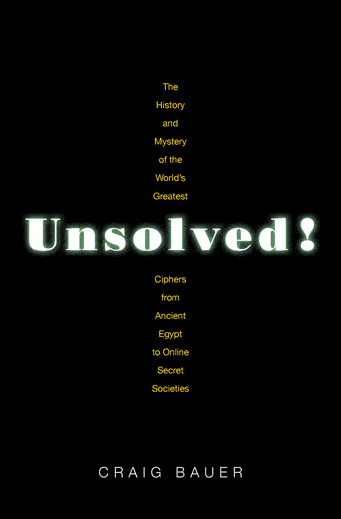“Unsolved! The History and Mystery of the World’s Greatest Ciphers from Ancient Egypt to Online Secret Societies”
By Craig P. Bauer
Princeton University Press, 624pp | Buy on Amazon
After the Sumerians invented writing more than 5,000 years ago, mankind went through a cultural explosion. This new paradigm freed us from the burden of having to pass down knowledge strictly orally, from person to person. Human memory, as we all can attest, can be fallible. As more and more people became literate, however, people had to devise ways to conceal the true meaning of their writing. Thus, the first ciphers were born.
In his latest book, Craig P. Bauer, an associate professor of mathematics at York College of Pennsylvania, introduces the uninitiated reader to the fascinating world of cryptography. To make this even more interesting, his book features some of the most mysterious ciphers and codes in history, some of them which remain unsolved to this day. These include the famous Voynich Manuscript but also other less known — though equally fascinating — crypto mysteries like the Dorabella cipher or the contemporary Cicada 3301 puzzle. There’s, of course, also a rundown of some of the most interesting ancient ciphers used by the Greeks, Romans or Vikings.
Bauer, who has served as a scholar in residence at the NSA’s Center for Cryptologic History, is a pretty good code-breaker himself. He shares some of his skills and knowledge by introducing the reader to some of the most common techniques and how to break them. One common technique is the MASC, where characters are substituted to disguise the original message just like a mask hides the identity of a person. It’s also one of the oldest encoding techniques, having been routinely used by Julius Caesar during his military campaigns. From here, the author presents some of the more sophisticated techniques which are used by spies and intelligence agencies. In no time, you should be able to cipher your own messages. You probably won’t fool the NSA but at least you’ll have some fun.
You’ll also learn about how some bizarre people claim to use cryptography techniques to communicate with the dead. Speaking of which, there are two chapters dedicated to both the ciphers left by serial killers like the Zodiac Killer but also those found on the bodies of various victims like the Unknown Man of Somerton Beach. And if you’re already a decent code breaker, Bauer has some challenges for you. Some have been unsolved for decades. Maybe you’ll be the one to crack them.
Being almost oblivious to how ciphers and encryption works, I found this book to be a fine introduction. Though it’s a rather hefty volume, over 600 pages long, I didn’t find reading it daunting as Bauer writes compellingly despite the wealth of technical information. This means that readers who just want to brush up on some cipher history as well those who want to really dive into it will find this book satisfying.



